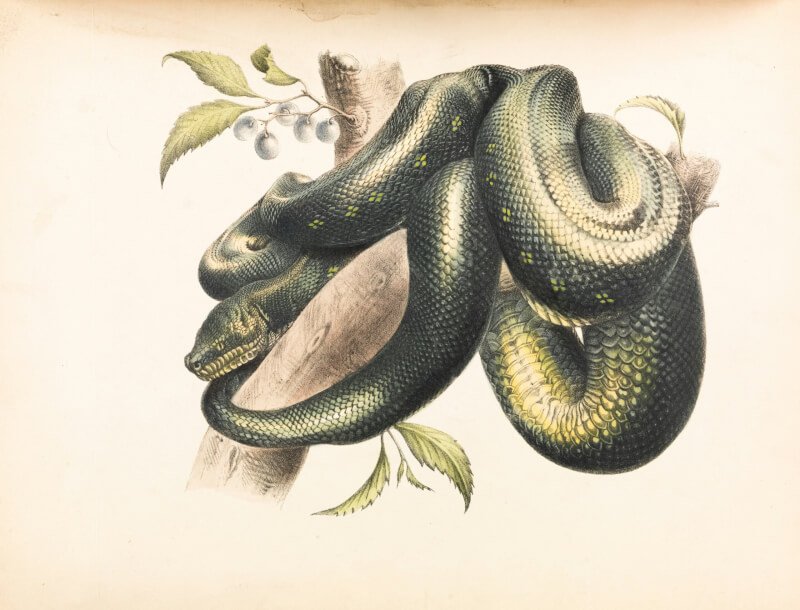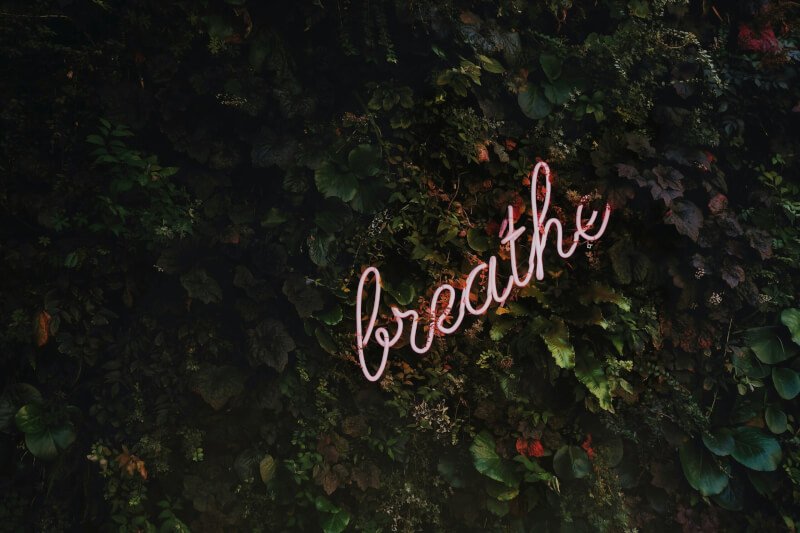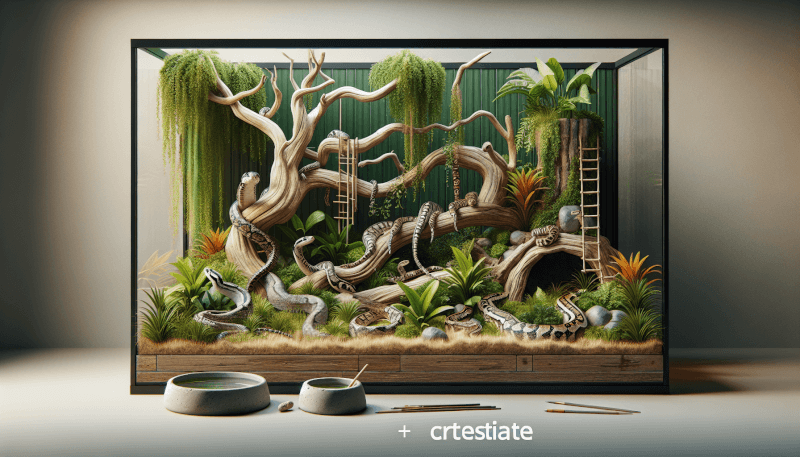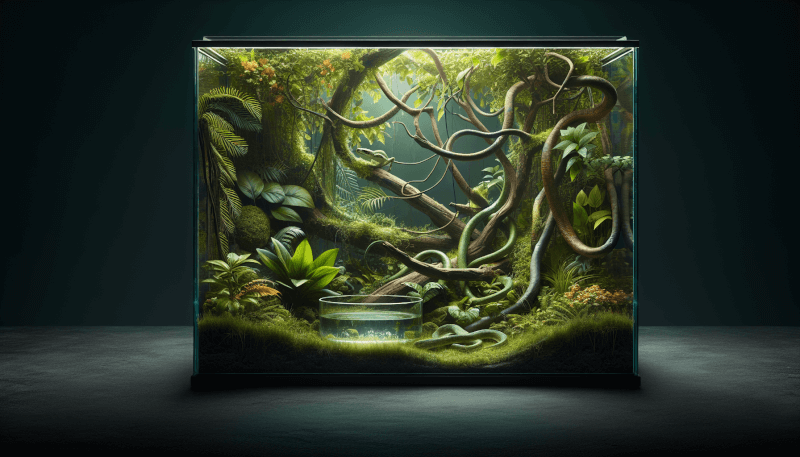Imagine creating a perfect habitat for your pet snake, where it can thrive and feel at home. In this article, we will explore the best ways to provide a naturalistic environment for your slithering companion. From designing an enclosure that mimics the snake’s natural habitat to providing hiding spots and appropriate temperature gradients, we will guide you through the steps to ensure your snake’s comfort and well-being. Get ready to transform your snake’s home into a paradise that truly reflects its wild origins.
Enclosure Type
Glass Tank
A glass tank is a popular choice for housing snakes because it provides excellent visibility and allows for easy monitoring of your snake’s behavior. Glass tanks are also easy to clean and maintain, making them a convenient option for snake keepers. However, it is essential to ensure proper ventilation by using a secure mesh lid or adding additional ventilation holes to prevent any buildup of humidity.
Plastic Tub
Plastic tubs are an alternative to glass tanks for snake enclosures. They are lightweight and provide a secure environment for your snake. Plastic tubs are also easy to clean and maintain, and they offer insulation, which can help maintain proper temperatures within the enclosure. However, it is crucial to choose a tub that is appropriately sized for your snake to ensure adequate space for movement.
Enclosure Size
Appropriate Dimensions
When determining the size of your snake’s enclosure, it is important to consider its adult size and species-specific requirements. Snakes need enough space to stretch out fully and move comfortably within their enclosure. A general rule of thumb is to provide an enclosure that is at least as long as the snake’s body length and twice as wide. This allows for proper movement and reduces stress on the snake.
Adequate Space
In addition to considering the dimensions of the enclosure, it is important to provide adequate space for various environmental enrichment items, such as hiding spots, branches, and perches. These accessories mimic the snake’s natural habitat and provide opportunities for exploration, exercise, and mental stimulation. By providing enough space, you can create a more naturalistic environment that promotes the overall well-being of your snake.

Temperature
Basking Spot
Snakes are ectothermic creatures, meaning they rely on external heat sources to regulate their body temperature. It is essential to provide a basking spot within the enclosure where your snake can raise its body temperature to aid in digestion and metabolism. The basking spot should be equipped with a heat source, such as a basking light or heat mat, and maintain a temperature range suitable for your particular snake species.
Cool Side
In addition to a basking spot, it is crucial to establish a cool side within the enclosure. This area should be away from the heat source and provide a temperature gradient, allowing your snake to thermoregulate by moving between warmer and cooler areas as needed. Providing this temperature variation mimics the snake’s natural environment and allows it to regulate its body temperature effectively.
Thermal Gradient
Maintaining a thermal gradient within the enclosure is vital for the overall health and well-being of your snake. This gradient refers to the range of temperatures available within the enclosure, from the cooler side to the basking spot. By establishing a proper thermal gradient, you allow your snake to choose and regulate its preferred temperature, which is essential for essential physiological functions such as digestion, shedding, and overall metabolic processes.
Humidity
Water Bowl
Maintaining appropriate humidity levels within the snake’s enclosure is crucial, as it can impact their overall health and the integrity of their skin. A water bowl should be provided at all times, allowing your snake to drink and soak as needed. This not only ensures hydration but also aids in the shedding process by providing a humid microenvironment.
Misting
For snake species that require higher humidity levels, such as tropical or rainforest species, misting the enclosure with water can help maintain the desired humidity level. This can be done using a spray bottle or automatic misting system, ensuring that the substrate and overall environment remain adequately moist. Regular monitoring of the humidity levels and adjusting misting frequency accordingly is necessary to prevent excessive or insufficient humidity.
Substrate
Choosing an appropriate substrate can also contribute to maintaining suitable humidity levels within the enclosure. Natural substrates, such as cypress mulch or coconut husk, can help retain moisture and create a more naturalistic environment for your snake. These substrates not only aid in maintaining humidity but also provide a comfortable and enriching substrate for burrowing or exploring behavior.

Lighting
UVB Lighting
While snakes are not typically exposed to direct sunlight in their natural habitats, some species still benefit from UVB lighting. UVB light enables proper calcium metabolism, which is essential for strong bones and overall health. If your snake species requires UVB lighting, it is important to provide a UVB bulb specifically designed for reptiles and follow the manufacturer’s recommendations for distance and duration of exposure.
Basking Light
In addition to UVB lighting, a basking light is necessary to provide the snake with a localized heat source for thermoregulation. Basking lights should be positioned to create a basking spot with the appropriate temperature range for your specific snake species. It is important to monitor the temperature regularly to ensure it remains within the recommended range and adjust the positioning of the basking light as needed.
Photoperiod
Maintaining a consistent photoperiod, or light-dark cycle, is crucial for a snake’s natural behavior and overall well-being. Mimicking the day-night cycle found in their natural habitat can help regulate their biological functions and promote healthy behaviors. Typically, a 12-hour light cycle is recommended, with lights being turned on and off at similar times each day.
Substrate
Natural Substrate
Choosing a natural substrate not only provides a more realistic and aesthetically pleasing environment for your snake but also offers various benefits. Natural substrates, such as aspen shavings or cypress mulch, mimic the forest floor or desert sand found in their natural habitats. These substrates can help absorb waste, control odor, and provide a comfortable surface for your snake to move on.
Absorbent Material
Using absorbent material, such as paper towels or reptile carpet, can be an alternative to natural substrates. This option is often preferred for snakes with specific health concerns, as it allows for easy monitoring of feces and reduces the risk of ingesting loose substrate. Additionally, absorbent material makes cleaning and maintenance more straightforward, ensuring a hygienic environment for your snake.

Hiding Spots
Cave or Hideout
Providing hiding spots within the enclosure is essential for your snake’s sense of security and stress reduction. A cave or hideout, such as a commercially available reptile hide or a half-log, offers a secluded and dark space for your snake to retreat to when it seeks privacy or feels threatened. Hiding spots should be appropriately sized for your snake to enter comfortably and should be placed in different areas of the enclosure to ensure accessibility.
Branches or Rocks
In addition to a hideout, incorporating branches or rocks within the enclosure provides a more naturalistic environment and opportunities for climbing and perching. These elevated surfaces mimic the snake’s natural habitat and encourage physical exercise and exploration. It is important to choose sturdy and stable branches or rocks to prevent any risk of collapse or injury to your snake.
Environmental Enrichment
Branches and Perches
Branches and perches offer more than just a climbing opportunity for snakes; they provide additional environmental enrichment. Snakes can use these structures to explore different heights, exercise muscles, and mimic their natural behavior. The addition of branches and perches also stimulates the snake’s mental well-being, providing new experiences and potentially mimicking the hunting and climbing behaviors observed in the wild.
Feeding Enrichment
Feeding enrichment involves introducing mental and physical challenges into the feeding routine, encouraging the snake to exhibit natural hunting behaviors. This can be accomplished by providing food items that require effort or puzzle feeders that encourage problem-solving. Feeding enrichment not only adds excitement to mealtime but also promotes physical activity and mental stimulation, leading to a healthier and happier snake.

Feeding
Prey Items
Providing appropriate prey items is crucial for the nutritional needs of your snake. Snakes are carnivorous and require prey items that match their species-specific dietary requirements. It is important to research and understand your snake’s natural diet to ensure proper feeding. Common prey items for snakes include appropriately-sized mice, rats, chicks, or other small mammals.
Feeding Schedule
Establishing a consistent feeding schedule is essential for maintaining your snake’s health and digestive functions. Snakes have varying feeding frequencies, depending on their species, age, and individual metabolism. Generally, juvenile snakes require more frequent feedings, while adult snakes may be fed less often. It is important to consult reliable sources or seek guidance from a reptile veterinarian to determine the appropriate feeding schedule for your snake.
Cleaning and Maintenance
Regular Cleaning
Maintaining a clean and hygienic enclosure is crucial for preventing the buildup of bacteria and potential health issues for your snake. Regular cleaning should include removing waste, uneaten food, and shed skin. The enclosure should be spot cleaned as needed and fully cleaned on a regular basis, using mild reptile-safe disinfectants. It is important to rinse thoroughly and allow the enclosure to dry completely before reintroducing your snake.
Preventing Bacteria
To prevent the growth of bacteria or mold, proper substrate maintenance is essential. Natural substrates should be replaced regularly to prevent excessive moisture, mold formation, or odor buildup. Absorbent materials should be changed as soon as they become soiled or damp. Maintaining cleanliness and providing a dry and suitable living environment can significantly contribute to the overall health and well-being of your snake.
In conclusion, providing a naturalistic environment for your snake involves considering various factors such as enclosure type and size, temperature regulation, humidity control, lighting, substrate choice, hiding spots, environmental enrichment, feeding, and cleaning. By ensuring your snake’s habitat mimics its natural environment as closely as possible, you can create a comfortable and enriching living space that promotes their overall health and well-being. Remember to research and understand your specific snake species’ requirements to provide the best care possible.



